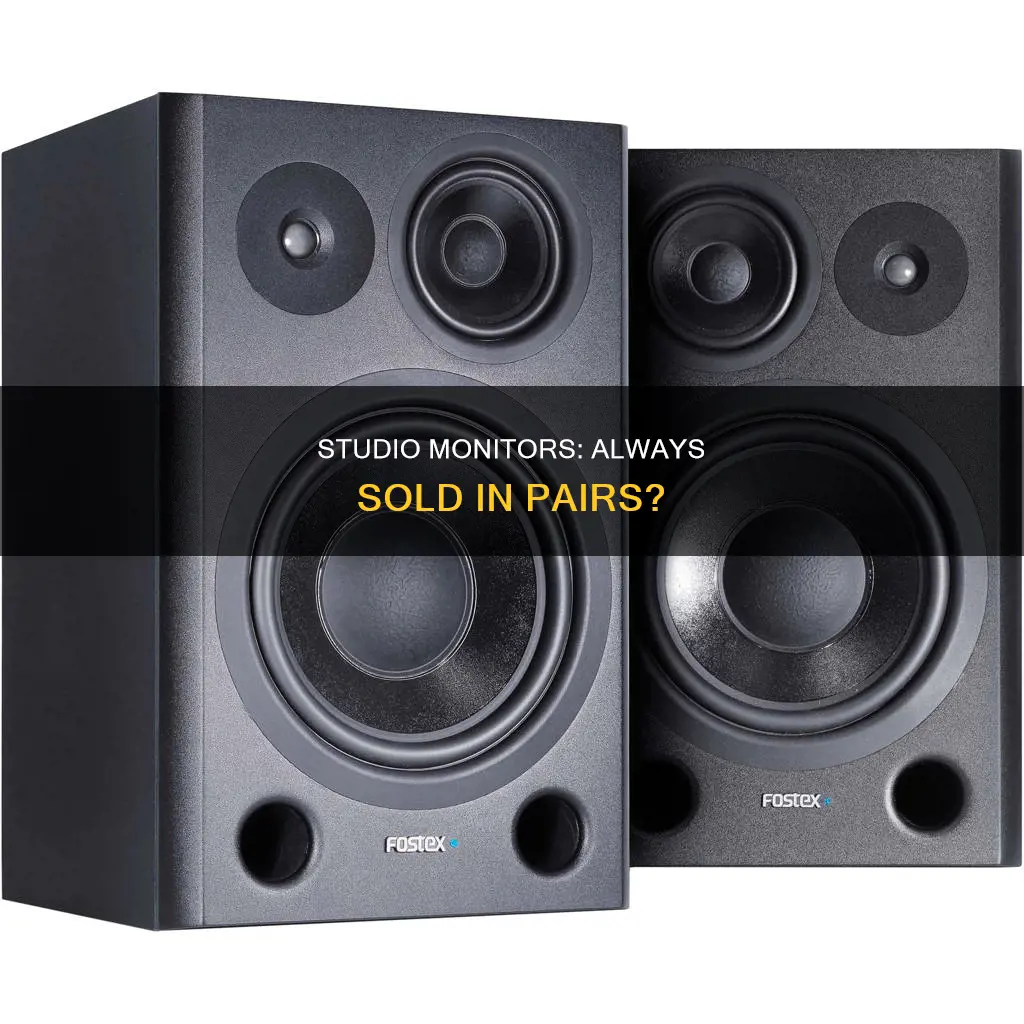
Studio monitors are a type of loudspeaker designed for professional audio production. They are used by mixing engineers to achieve the best possible sound. Studio monitors are available in pairs or as single units, depending on the manufacturer and model. Some retailers indicate whether the product is priced per unit or per pair. Studio monitors are also used in multiples by engineers to simulate the wide variety of speakers, earphones, and headphones used by listeners.
| Characteristics | Values |
|---|---|
| Sold as a pair | Some are sold in pairs, some individually. |
| Sold as a pair (reasoning) | Marketing strategy; selling one at a time at a lower price sounds better than selling a pair at a higher price. |
| Sold as a pair (reasoning) | For surround set-ups (5.1, 7.1, etc.). |
| Sold as a pair (reasoning) | To stabilise output and increase the 'sweet spot'. |
| Sold as a pair (reasoning) | To avoid having to buy a new pair if one monitor breaks. |
| Sold as a pair (reasoning) | To allow for A/B testing. |
| Sold as a pair (reasoning) | To allow for a balanced stereo mix of sounds. |
| Sold individually (reasoning) | For those who don't need a pair. |
| Sold individually (reasoning) | For those who want to create an odd-number-of-monitors configuration. |
| Sold individually (reasoning) | To allow for customisation and personal preference. |
What You'll Learn
- Studio monitors are sold both individually and in pairs
- Studio monitors are designed to be as neutral as possible
- Active monitors have built-in amplifiers, passive monitors require separate amplifiers
- Multiple pairs of studio monitors are used to achieve the best possible sound
- Studio monitors come in different designs, such as active and passive, nearfield or midfield

Studio monitors are sold both individually and in pairs
Studio monitors are indeed sold both individually and in pairs.
Studio monitors are a type of loudspeaker designed for professional audio production, such as in recording studios, radio stations, and post-production houses. They are engineered to be neutral sound sources, projecting sound with a flat response curve and very low levels of harmonic distortion. This allows audio engineers to hear an accurate representation of the audio and make precise adjustments during recording, mixing, and mastering processes.
When purchasing studio monitors, it is important to consider your budget, with prices ranging from $500 to tens of thousands of dollars per pair. Active monitors, which have built-in amplifiers, are commonly chosen by home studio producers, while passive monitors require a separate amplifier. Another factor to consider is the size and number of drivers, which can range from 5 to 8.75 inches for low-frequency cones.
Some people prefer to buy studio monitors in pairs to ensure a balanced stereo mix. It is also common for studios to employ multiple pairs of monitors to achieve the best possible sound. This allows engineers to simulate the wide variety of speakers, earphones, and headphones used by listeners, ensuring that their mix will sound good on all playback systems.
In conclusion, studio monitors are available for purchase as single units or in pairs, catering to diverse user needs and preferences.
Monitor Sizes: Bezels Included or Not?
You may want to see also

Studio monitors are designed to be as neutral as possible
If your studio monitors aren't providing an accurate representation of the frequency content of your music, it will negatively impact your ability to record and mix successfully. Your mixes might sound good in your studio but nowhere else, indicating that your monitors are at least partially to blame.
Studio monitors are different from regular speakers, which often hype specific frequency ranges to make music more exciting for the listener. Studio monitors, on the other hand, are designed to deliver a flat-frequency response, producing sound exactly as it is received. This allows you to make mixes that will translate well on a variety of different systems.
Ankle Monitors: How Long Do They Stay On?
You may want to see also

Active monitors have built-in amplifiers, passive monitors require separate amplifiers
Studio monitors are a crucial component of any recording studio setup, and one of the key decisions you'll make when choosing your monitors is whether to go with active or passive models. This choice will significantly impact the sound quality and flexibility of your recording setup.
Active monitors have built-in amplifiers, offering a streamlined and convenient solution. They are designed to provide a cohesive sound experience right out of the box and simplify the cabling process. The integration of the amplifier and speakers can also enhance synergy and performance. Active monitors are typically heavier and may require more power due to the built-in amplification. They are often more expensive upfront due to the built-in amplifiers but can be more cost-effective in the long run as no extra equipment is needed.
On the other hand, passive monitors require separate amplifiers, giving you more customisation options. You can select and upgrade your amplifier to tailor your sound system to your specific needs. This flexibility also extends to adding components like a subwoofer to enhance lower frequencies. Passive monitors are usually lighter and more portable, making them easier to mount and position. They are typically less expensive upfront but may end up costing more in the long run due to the need for separate amplifiers.
When deciding between active and passive studio monitors, consider your priorities. If you value convenience and a simpler setup, active monitors are a good choice. If you prefer customisation and the ability to fine-tune your sound, passive monitors might be a better option. Keep in mind factors such as your budget, space constraints, and the level of customisation you desire.
LCD Monitor Refurbishing: A Step-by-Step Guide to Success
You may want to see also

Multiple pairs of studio monitors are used to achieve the best possible sound
Using multiple pairs of studio monitors allows engineers to get a more comprehensive and precise representation of the audio they are working on. This helps ensure that the final product sounds as good as possible across various playback systems.
- Room Acoustics: The sound of a room can significantly impact how audio is perceived. Multiple monitors in different locations help engineers understand how audio will sound in different environments, allowing them to make necessary adjustments.
- Frequency Range: Different monitors have different frequency ranges, which affect how certain frequencies are perceived. Multiple monitors enable engineers to hear how different parts of the audio spectrum are represented and make adjustments for a balanced sound.
- Personal Preference: Engineers use different monitors to cater to varying preferences for how a mix should sound. This allows them to compare the mix on different speakers and make adjustments to achieve the desired result.
- Mix Translation: Engineers want to ensure that their mix will sound good on various playback systems, from high-end studio monitors to low-end laptop speakers. Multiple monitors help them hear how the mix translates to different systems and make necessary adjustments.
- Masking Effect: The masking effect occurs when sound from one frequency range is obscured by another. This effect can only be identified on certain monitors, so engineers use multiple monitors to find and eliminate this issue in their mix.
Additionally, having multiple pairs of studio monitors of different sizes and types allows engineers to hear the low end and other frequency ranges in new ways. For example, larger monitors with eight-inch woofers provide clearer and more succinct low-end reproduction compared to smaller monitors with five-inch woofers.
In summary, multiple pairs of studio monitors are used to achieve the best possible sound by providing a more comprehensive and precise representation of the audio. This helps engineers make adjustments that ensure the final mix sounds great across different playback systems and accounts for room acoustics, frequency ranges, and personal preferences.
Resetting Your ASUS VG245 Monitor: A Step-by-Step Guide
You may want to see also

Studio monitors come in different designs, such as active and passive, nearfield or midfield
Studio monitors come in a variety of designs, and can be purchased either individually or in pairs. When shopping for studio monitors, it's important to consider the specific needs of your studio setup. Here are some key design aspects to keep in mind:
Active vs Passive Monitors
Passive monitors require an external power amplifier and have a built-in passive crossover, whereas active monitors have built-in amplifiers and crossovers. Active monitors are typically more convenient for home studios as they don't require purchasing and calibrating an external amplifier. They are also designed so that the built-in amplifiers match the drivers well. However, passive monitors offer more flexibility in terms of customising your setup by allowing you to choose a specific amplifier that suits your preferences.
Nearfield vs Midfield vs Farfield Monitors
The designation of nearfield, midfield, or farfield monitors depends on the distance from the listener. Nearfield monitors are placed closer to the listener (around 2-3 feet away) and are typically more affordable and suitable for smaller studios. Midfield monitors are placed further away (up to 4 meters) and offer improved frequency response and fidelity but require a larger, acoustically treated room. Farfield monitors, also known as "mains" or "bigs", are usually found in high-end professional studios and are built into the control room walls. They tend to be very large, loud, and expensive.
When choosing between these options, consider the size and acoustics of your studio space. For smaller rooms, nearfield monitors are generally the best choice, while midfield monitors are suitable if you have a larger space with proper acoustic treatment. Farfield monitors are typically reserved for large, high-end studios.
Two-way vs Three-way Monitors
Two-way monitors have two drivers: a woofer for low frequencies and a tweeter for high frequencies. Three-way monitors add a dedicated midrange driver, resulting in improved frequency response, lower distortion, and potentially extended low-frequency response. However, three-way monitors are usually more expensive and complex to design. The choice between two-way and three-way monitors depends on your studio size and budget.
Enlarging Dual Monitors: A Simple 10-Step Guide
You may want to see also
Frequently asked questions
No. Some are sold in pairs, but some are sold individually. This is usually indicated on the product page next to the price.
Studio monitors are designed to be as accurate and neutral as possible, allowing audio engineers to hear a true representation of the audio and make precise adjustments during the recording, mixing, and mastering processes.
Using multiple pairs of studio monitors allows mixing engineers to get a more complete and accurate representation of the audio they are working on and make adjustments to ensure that the final product sounds as good as possible on a variety of systems.







